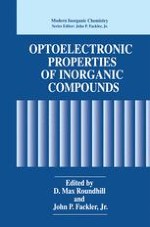1999 | OriginalPaper | Buchkapitel
Optical Sensors with Metal Ions
verfasst von : D. Max Roundhill
Erschienen in: Optoelectronic Properties of Inorganic Compounds
Verlag: Springer US
Enthalten in: Professional Book Archive
Aktivieren Sie unsere intelligente Suche, um passende Fachinhalte oder Patente zu finden.
Wählen Sie Textabschnitte aus um mit Künstlicher Intelligenz passenden Patente zu finden. powered by
Markieren Sie Textabschnitte, um KI-gestützt weitere passende Inhalte zu finden. powered by
Optical sensors are materials that potentially have a wide range of uses and applications in both medical and environmental situations among others. Optical sensors can be designed to make use of changes in the wavelengths or extinction coefficients of the sensing material. Alternately for emissive materials, it is possible to use changes in the emission wavelengths or intensities to monitor the presence or absence of chemical species. These chemical species can be cations, anions, or organic molecules. For a sensor to be useful it is necessary for the device to be selective for the specific chemical species of interest, and that the change in the property of the sensing material be responsive in a consistent manner to changes in concentration of the chemical species being detected or analyzed.1–8 This chapter is focused on optical sensors incorporating metals, and one feature of such sensors is their use to detect metal ions in solutions. For the metal binding site in such a sensor it is usual to employ chelate or macrocyclic ligands because they can be tailored to selectively complex a variety of different metal ions. For the detection of uncharged molecules a host will usually be selected such that its cavity matches the shape and size of the chosen guest. More recently metal-containing optical sensors are being developed that can function as anion selective receptors, and again the receptor must be specifically designed to meet the requirements of the individual anions.9
